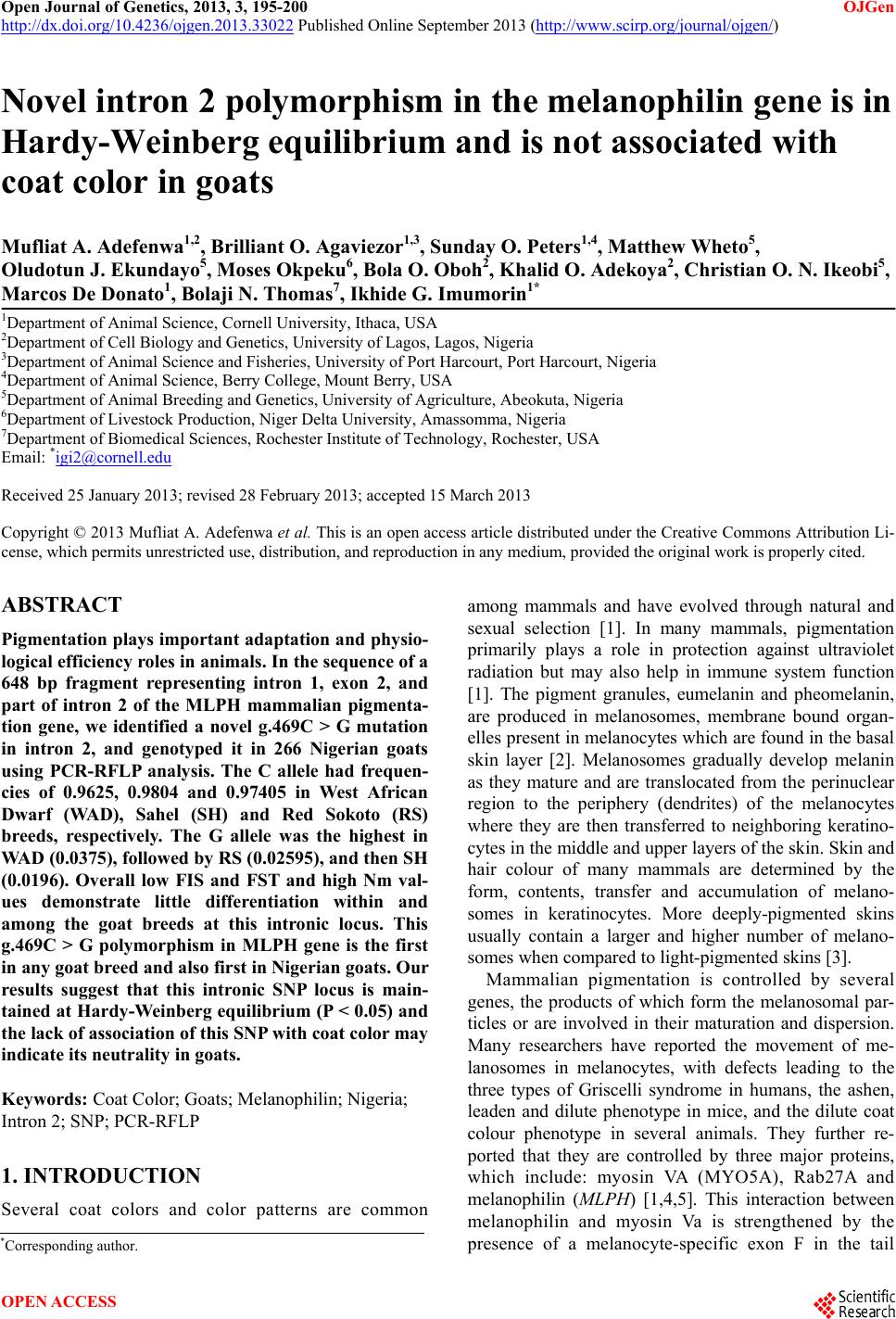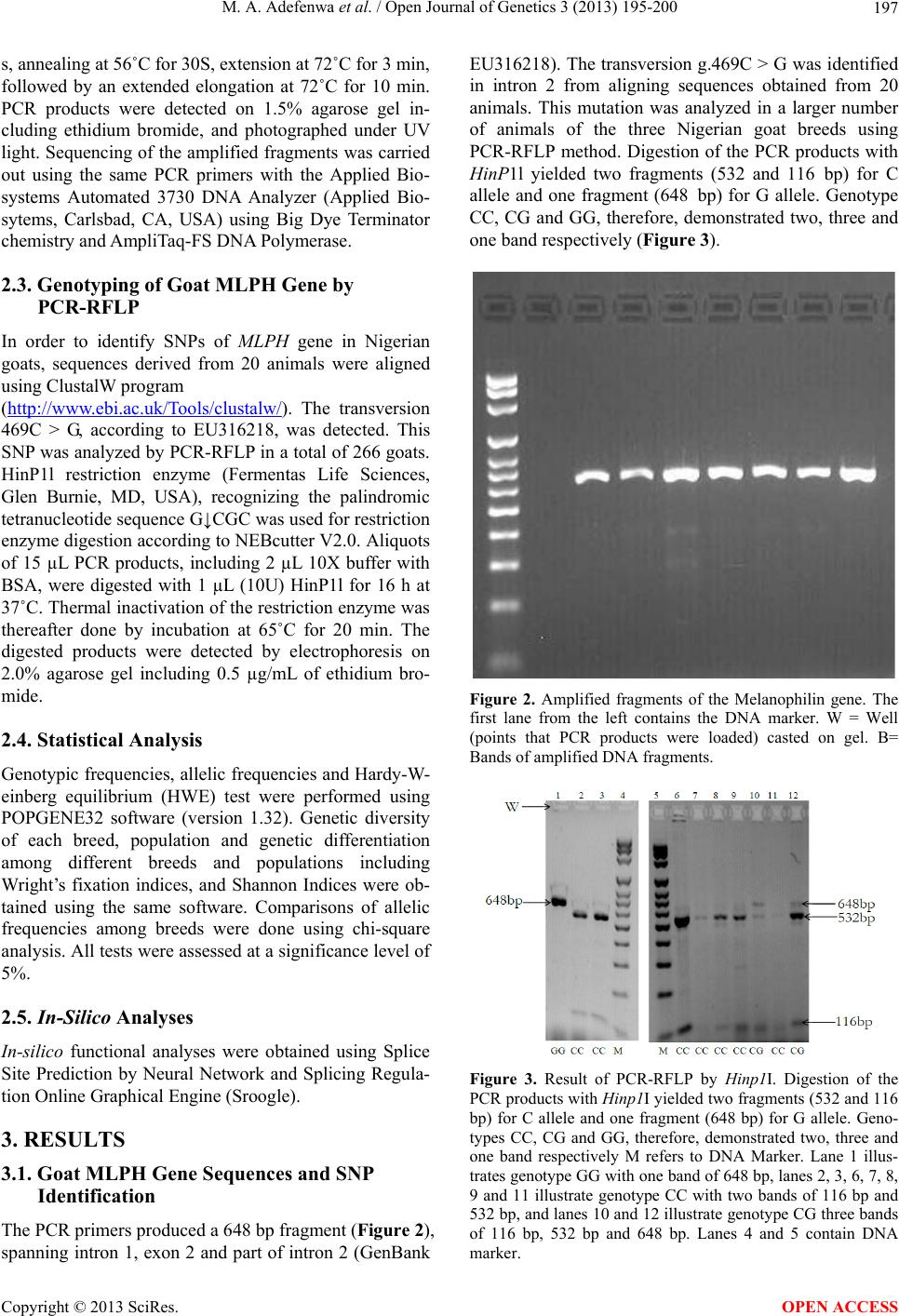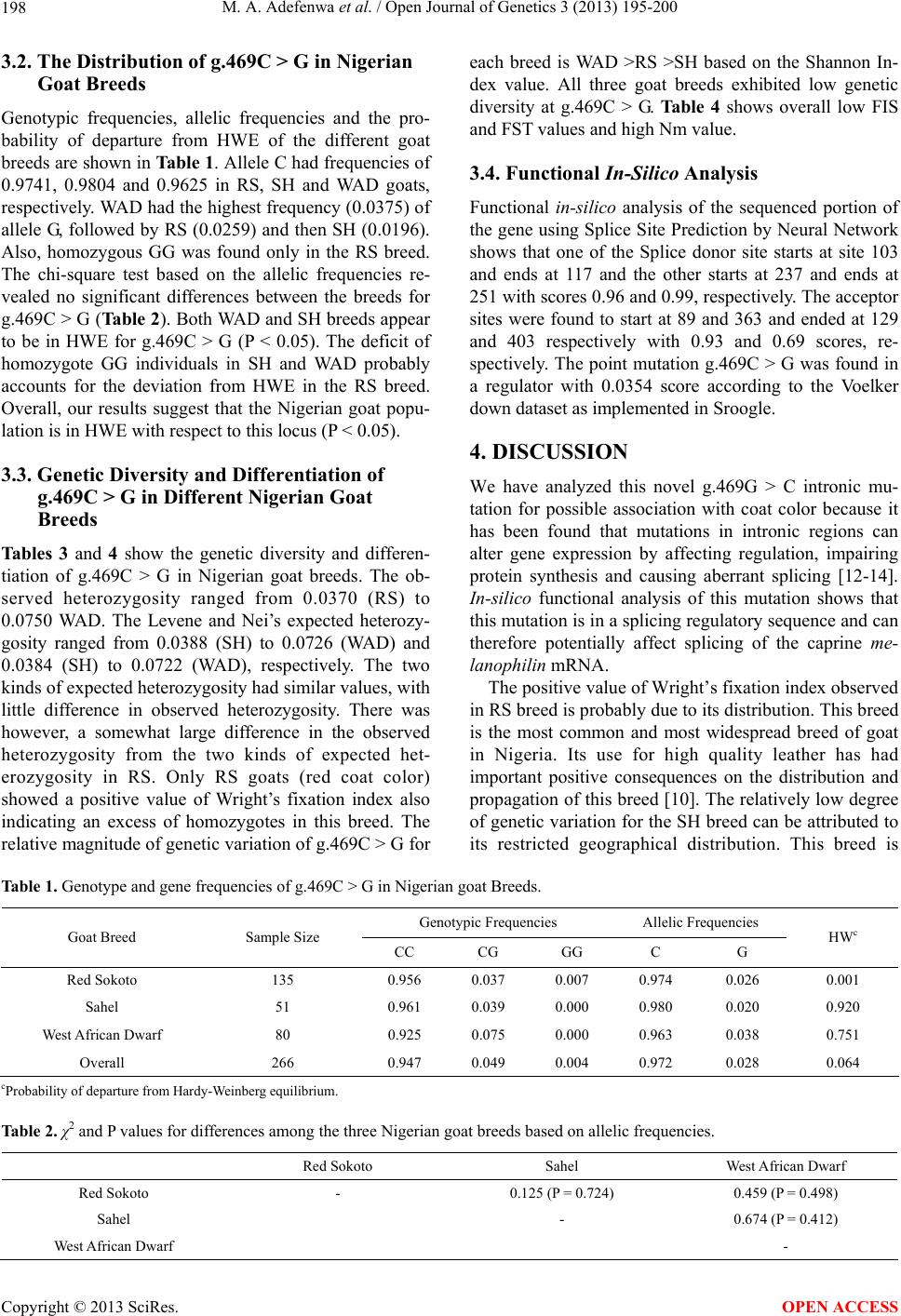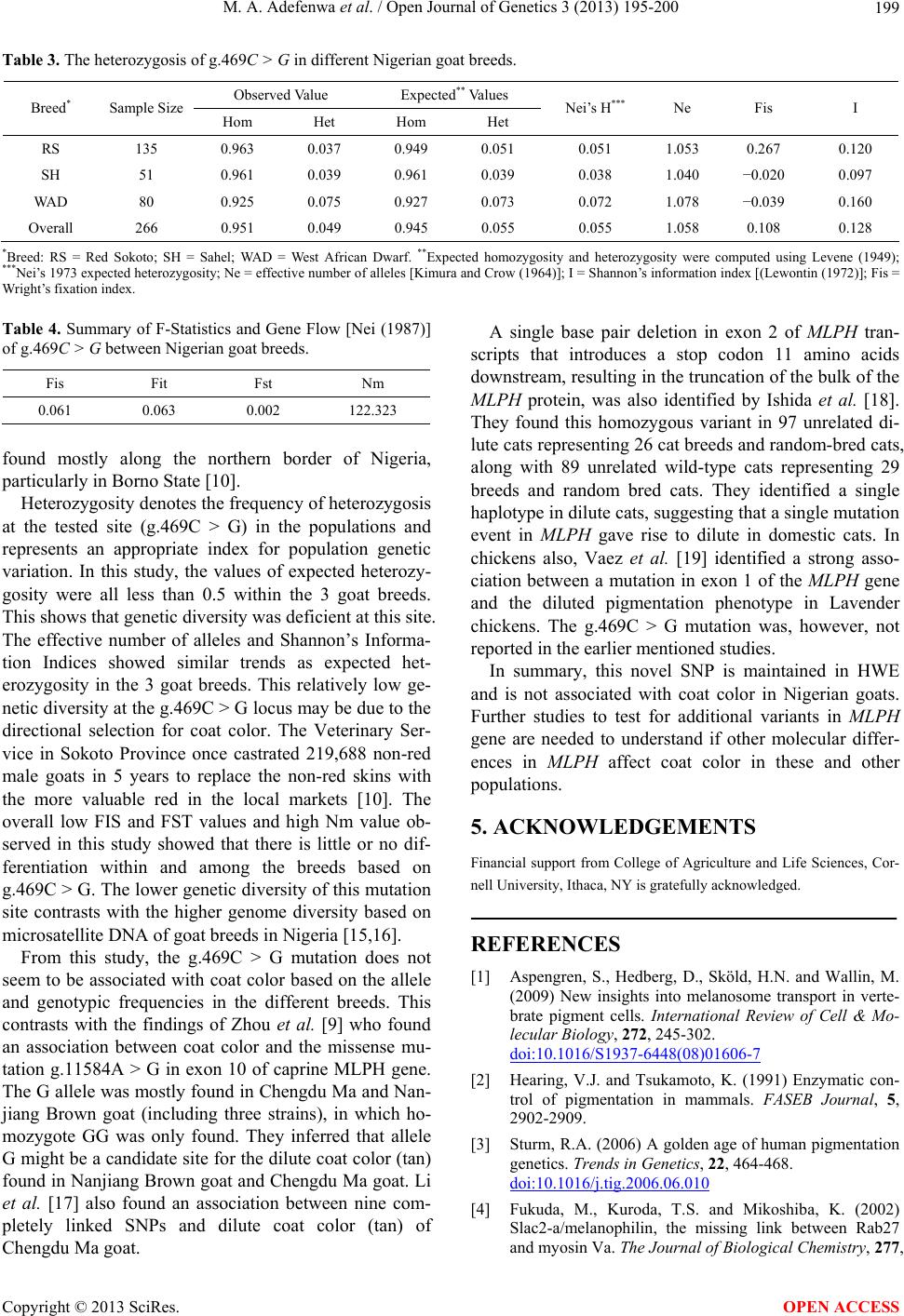 Open Journal of Genetics, 2013, 3, 195-200 OJGen http://dx.doi.org/10.4236/ojgen.2013.33022 Published Online September 2013 (http://www.scirp.org/journal/ojgen/) Novel intron 2 polymorphism in the melanophilin gene is in Hardy-Weinberg equilibrium and is not associated with coat color in goats Mufliat A. Adefenwa1,2, Brilliant O. Agaviezor1,3, Sunday O. Peters1,4, Matthew Wheto5, Oludotun J. Ekundayo5, Moses Okpeku6, Bola O. Oboh2, Khalid O. Adekoya2, Christian O. N. Ikeobi5, Marcos De Donato1, Bolaji N. Thomas7, Ikhide G. Imumorin1* 1Department of Animal Science, Cornell University, Ithaca, USA 2Department of Cell Biology and Genetics, University of Lagos, Lagos, Nigeria 3Department of Animal Science and Fisheries, University of Port Harcourt, Port Harcourt, Nigeria 4Department of Animal Science, Berry College, Mount Berry, USA 5Department of Animal Breeding and Genetics, University of Agriculture, Abeokuta, Nigeria 6Department of Livestock Production, Niger Delta University, Amassomma, Nigeria 7Department of Biomedical Sciences, Rochester Institute of Technology, Rochester, USA Email: *igi2@cornell.edu Received 25 January 2013; revised 28 February 2013; accepted 15 March 2013 Copyright © 2013 Mufliat A. Adefenwa et al. This is an open access article distributed under the Creative Commons Attribution Li- cense, which permits unrestricted use, distribution, and reproduction in any medium, provided the original work is properly cited. ABSTRACT Pigmentation plays important adaptation and physio- logical efficiency roles in animals. In the sequence of a 648 bp fragment representing intron 1, exon 2, and part of intron 2 of the MLPH mammalian pigmenta- tion gene, we identified a novel g.469C > G mutation in intron 2, and genotyped it in 266 Nigerian goats using PCR-RFLP analysis. The C allele had frequen- cies of 0.9625, 0.9804 and 0.97405 in West African Dwarf (WAD), Sahel (SH) and Red Sokoto (RS) breeds, respectively. The G allele was the highest in WAD (0.0375), followed by RS (0.0259 5), and then SH (0.0196). Overall low FIS and FST and high Nm val- ues demonstrate little differentiation within and among the goat breeds at this intronic locus. This g.469C > G polymorphism in MLPH gene is the first in any goat breed and also first in Nigerian goats. Our results suggest that this intronic SNP locus is main- tained at Hardy-Weinberg equilibrium (P < 0.05) and the lack of association of this SNP with coat color may indicate its neutrality in goats. Keywords: Coat Color; Goats; Melanophilin; Nigeria; Intron 2; SNP; PCR-RFLP 1. INTRODUCTION Several coat colors and color patterns are common among mammals and have evolved through natural and sexual selection [1]. In many mammals, pigmentation primarily plays a role in protection against ultraviolet radiation but may also help in immune system function [1]. The pigment granules, eumelanin and pheomelanin, are produced in melanosomes, membrane bound organ- elles present in melanocytes which are found in the basal skin layer [2]. Melanosomes gradually develop melanin as they mature and are translocated from the perinuclear region to the periphery (dendrites) of the melanocytes where they are then transferred to neighboring keratino- cytes in the middle and upper layers of the skin. Skin and hair colour of many mammals are determined by the form, contents, transfer and accumulation of melano- somes in keratinocytes. More deeply-pigmented skins usually contain a larger and higher number of melano- somes when compared to light-pigmented skins [3]. Mammalian pigmentation is controlled by several genes, the products of which form the melanosomal par- ticles or are involved in their maturation and dispersion. Many researchers have reported the movement of me- lanosomes in melanocytes, with defects leading to the three types of Griscelli syndrome in humans, the ashen, leaden and dilute phenotype in mice, and the dilute coat colour phenotype in several animals. They further re- ported that they are controlled by three major proteins, which include: myosin VA (MYO5A), Rab27A and melanophilin (MLPH) [1,4,5]. This interaction between melanophilin and myosin Va is strengthened by the presence of a melanocyte-specific exon F in the tail *Corresponding author. OPEN ACCESS  M. A. Adefenwa et al. / Open Journal of Genetics 3 (2013) 195-200 196 domain of myosin-Va [4,6,7]. Mutations in melanophilin gene have been associated with coat color dilution in some mammals. Philipp et al. [8] reported strong associations of single nucleotide polymorphisms in exon 2 of MLPH and color in dilute Doberman pinschers, Beagles, and Large munsterlanders and in exon 7 in dilute German pinschers. Zhou et al. [9] also found a missense mutation of g.115844A > G in exon 10 in goat melanophilin gene and inferred from their results that allele G might be responsible for the tan color observed in some of the goat breeds in China. There are no published studies on melanophilin gene in Nigerian indigenous goats. The three major goat breeds in Nigeria exhibit specific coat colors except for occa- sional within breed color variation. The West African Dwarf is usually black; the Sahel goat is commonly white while the Red Sokoto is mostly red. In this study, we identified a novel intronic SNP in the caprine melanophilin gene and investigated the association of this polymorphism with coat color and its differentiation among Nigerian goat populations. 2. MATERIALS AND METHODS 2.1. Animals and DNA Samples Nigeria is located in West Africa on the Gulf of Guinea (latitude 10˚00'N, longitude 8˚00'E) with a total area of 923,768 km2. Nigeria is bounded by Niger, Benin and Cameroon Republics on the North, West and East, re- spectively. The sample was made up of 266 goats of the three major breeds of goats in Nigeria; WAD (n = 80), RS (n = 135) and SH (n = 51) collected from farms and markets across Nigeria, according to the geographical distribution of the breeds published by Blench [10] with locations shown in Figure 1. Blood samples were col- lected by jugular venipuncture from individual animals and genomic DNA from collected blood samples were isolated using ZymoBeadTM Genomic DNA kit (Zymo Research Corporation, Irvine, CA, USA) following the manufacturer’s instructions. Quantification of DNA yield and assessment of quality were done using a Nanodrop ND-100 UV/Vis Spectrophotometer (Nanodrop Tech- nologies, Inc., Wilmington, DE, USA). 2.2. Isolation and Sequencing of Melanophilin Gene Fragments Using information from Feng et al. [11], a pair of PCR primers (F: 5’-CGTGGGTTCCCTTATTTTGAC-3’ and R: 5’-ATCCTGGCTTCTGGGTGTTG-3’) was synthe- sized to amplify a 648 bp fragment spanning intron 1, exon 2 and part of intron 2. PCR amplifications were carried out in a C1000TM Thermal Cycler (Biorad, Her- cules, CA, USA) in a total reaction volume of 20 µL containing approximately 50 ng DNA, 10 pmol of each primer in AccuPowerTM PCR Premix (Bioneer Corpora- tion, Alameda, CA, USA). The PCR cycling conditions are as follows: denaturation at 95˚C for 4 min, followed by 35 amplification cycles of denaturation at 94˚C for 30 Figure 1. Sites of sampling collection. Copyright © 2013 SciRes. OPEN ACCESS  M. A. Adefenwa et al. / Open Journal of Genetics 3 (2013) 195-200 197 s, annealing at 56˚C for 30S, extension at 72˚C for 3 min, followed by an extended elongation at 72˚C for 10 min. PCR products were detected on 1.5% agarose gel in- cluding ethidium bromide, and photographed under UV light. Sequencing of the amplified fragments was carried out using the same PCR primers with the Applied Bio- systems Automated 3730 DNA Analyzer (Applied Bio- sytems, Carlsbad, CA, USA) using Big Dye Terminator chemistry and AmpliTaq-FS DNA Polymerase. 2.3. Genotyping of Goat MLPH Gene by PCR-RFLP In order to identify SNPs of MLPH gene in Nigerian goats, sequences derived from 20 animals were aligned using ClustalW program (http://www.ebi.ac.uk/Tools/clustalw/). The transversion 469C > G, according to EU316218, was detected. This SNP was analyzed by PCR-RFLP in a total of 266 goats. HinP1l restriction enzyme (Fermentas Life Sciences, Glen Burnie, MD, USA), recognizing the palindromic tetranucleotide sequence G↓CGC was used for restriction enzyme digestion according to NEBcutter V2.0. Aliquots of 15 µL PCR products, including 2 µL 10X buffer with BSA, were digested with 1 µL (10U) HinP1l for 16 h at 37˚C. Thermal inactivation of the restriction enzyme was thereafter done by incubation at 65˚C for 20 min. The digested products were detected by electrophoresis on 2.0% agarose gel including 0.5 µg/mL of ethidium bro- mide. 2.4. Statistical Analysis Genotypic frequencies, allelic frequencies and Hardy-W- einberg equilibrium (HWE) test were performed using POPGENE32 software (version 1.32). Genetic diversity of each breed, population and genetic differentiation among different breeds and populations including Wright’s fixation indices, and Shannon Indices were ob- tained using the same software. Comparisons of allelic frequencies among breeds were done using chi-square analysis. All tests were assessed at a significance level of 5%. 2.5. In-Silico Analyses In-silico functional analyses were obtained using Splice Site Prediction by Neural Network and Splicing Regula- tion Online Graphical Engine (Sroogle). 3. RESULTS 3.1. Goat MLPH Gene Sequences and SNP Identification The PCR primers produced a 648 bp fragment (Figure 2), spanning intron 1, exon 2 and part of intron 2 (GenBank EU316218). The transversion g.469C > G was identified in intron 2 from aligning sequences obtained from 20 animals. This mutation was analyzed in a larger number of animals of the three Nigerian goat breeds using PCR-RFLP method. Digestion of the PCR products with HinP1l yielded two fragments (532 and 116 bp) for C allele and one fragment (648 bp) for G allele. Genotype CC, CG and GG, therefore, demonstrated two, three and one band respectively (Figure 3). Figure 2. Amplified fragments of the Melanophilin gene. The first lane from the left contains the DNA marker. W = Well (points that PCR products were loaded) casted on gel. B= Bands of amplified DNA fragments. Figure 3. Result of PCR-RFLP by Hinp1I. Digestion of the PCR products with Hinp1I yielded two fragments (532 and 116 bp) for C allele and one fragment (648 bp) for G allele. Geno- types CC, CG and GG, therefore, demonstrated two, three and one band respectively M refers to DNA Marker. Lane 1 illus- trates genotype GG with one band of 648 bp, lanes 2, 3, 6, 7, 8, 9 and 11 illustrate genotype CC with two bands of 116 bp and 532 bp, and lanes 10 and 12 illustrate genotype CG three bands of 116 bp, 532 bp and 648 bp. Lanes 4 and 5 contain DNA marker. Copyright © 2013 SciRes. OPEN ACCESS  M. A. Adefenwa et al. / Open Journal of Genetics 3 (2013) 195-200 198 3.2. The Distribution of g.469C > G in Nigerian Goat Breeds Genotypic frequencies, allelic frequencies and the pro- bability of departure from HWE of the different goat breeds are shown in Table 1. Allele C had frequencies of 0.9741, 0.9804 and 0.9625 in RS, SH and WAD goats, respectively. WAD had the highest frequency (0.0375) of allele G, followed by RS (0.0259) and then SH (0.0196). Also, homozygous GG was found only in the RS breed. The chi-square test based on the allelic frequencies re- vealed no significant differences between the breeds for g.469C > G (Table 2). Both WAD and SH breeds appear to be in HWE for g.469C > G (P < 0.05). The deficit of homozygote GG individuals in SH and WAD probably accounts for the deviation from HWE in the RS breed. Overall, our results suggest that the Nigerian goat popu- lation is in HWE with respect to this locus (P < 0.05). 3.3. Genetic Diversity and Differentiation of g.469C > G in Different Nigerian Goat Breeds Ta b le s 3 and 4 show the genetic diversity and differen- tiation of g.469C > G in Nigerian goat breeds. The ob- served heterozygosity ranged from 0.0370 (RS) to 0.0750 WAD. The Levene and Nei’s expected heterozy- gosity ranged from 0.0388 (SH) to 0.0726 (WAD) and 0.0384 (SH) to 0.0722 (WAD), respectively. The two kinds of expected heterozygosity had similar values, with little difference in observed heterozygosity. There was however, a somewhat large difference in the observed heterozygosity from the two kinds of expected het- erozygosity in RS. Only RS goats (red coat color) showed a positive value of Wright’s fixation index also indicating an excess of homozygotes in this breed. The relative magnitude of genetic variation of g.469C > G for each breed is WAD >RS >SH based on the Shannon In- dex value. All three goat breeds exhibited low genetic diversity at g.469C > G. Ta b l e 4 shows overall low FIS and FST values and high Nm value. 3.4. Functional In-Silico Analysis Functional in-silico analysis of the sequenced portion of the gene using Splice Site Prediction by Neural Network shows that one of the Splice donor site starts at site 103 and ends at 117 and the other starts at 237 and ends at 251 with scores 0.96 and 0.99, respectively. The acceptor sites were found to start at 89 and 363 and ended at 129 and 403 respectively with 0.93 and 0.69 scores, re- spectively. The point mutation g.469C > G was found in a regulator with 0.0354 score according to the Voelker down dataset as implemented in Sroogle. 4. DISCUSSION We have analyzed this novel g.469G > C intronic mu- tation for possible association with coat color because it has been found that mutations in intronic regions can alter gene expression by affecting regulation, impairing protein synthesis and causing aberrant splicing [12-14]. In-silico functional analysis of this mutation shows that this mutation is in a splicing regulatory sequence and can therefore potentially affect splicing of the caprine me- lanophilin mRNA. The positive value of Wright’s fixation index observed in RS breed is probably due to its distribution. This breed is the most common and most widespread breed of goat in Nigeria. Its use for high quality leather has had important positive consequences on the distribution and propagation of this breed [10]. The relatively low degree of genetic variation for the SH breed can be attributed to its restricted geographical distribution. This breed is Table 1. Genotype and gene frequencies of g.469C > G in Nigerian goat Breeds. Genotypic Frequencies Allelic Frequencies Goat Breed Sample Size CC CG GG C G HWc Red Sokoto 135 0.956 0.037 0.007 0.974 0.026 0.001 Sahel 51 0.961 0.039 0.000 0.980 0.020 0.920 West African Dwarf 80 0.925 0.075 0.000 0.963 0.038 0.751 Overall 266 0.947 0.049 0.004 0.972 0.028 0.064 cProbability of departure from Hardy-Weinberg equilibrium. Table 2. χ2 and P values for differences among the three Nigerian goat breeds based on allelic frequencies. Red Sokoto Sahel West African Dwarf Red Sokoto - 0.125 (P = 0.724) 0.459 (P = 0.498) Sahel - 0.674 (P = 0.412) West African Dwarf - Copyright © 2013 SciRes. OPEN ACCESS  M. A. Adefenwa et al. / Open Journal of Genetics 3 (2013) 195-200 199 Table 3. The heterozygosis of g.469C > G in different Nigerian goat breeds. Observed Value Expected** Values Breed* Sample Size Hom Het Hom Het Nei’s H*** Ne Fis I RS 135 0.963 0.037 0.949 0.051 0.051 1.053 0.267 0.120 SH 51 0.961 0.039 0.961 0.039 0.038 1.040 −0.020 0.097 WAD 80 0.925 0.075 0.927 0.073 0.072 1.078 −0.039 0.160 Overall 266 0.951 0.049 0.945 0.055 0.055 1.058 0.108 0.128 *Breed: RS = Red Sokoto; SH = Sahel; WAD = West African Dwarf. **Expected homozygosity and heterozygosity were computed using Levene (1949); ***Nei’s 1973 expected heterozygosity; Ne = effective number of alleles [Kimura and Crow (1964)]; I = Shannon’s information index [(Lewontin (1972)]; Fis = Wright’s fixation index. Table 4. Summary of F-Statistics and Gene Flow [Nei (1987)] of g.469C > G between Nigerian goat breeds. Fis Fit Fst Nm 0.061 0.063 0.002 122.323 found mostly along the northern border of Nigeria, particularly in Borno State [10]. Heterozygosity denotes the frequency of heterozygosis at the tested site (g.469C > G) in the populations and represents an appropriate index for population genetic variation. In this study, the values of expected heterozy- gosity were all less than 0.5 within the 3 goat breeds. This shows that genetic diversity was deficient at this site. The effective number of alleles and Shannon’s Informa- tion Indices showed similar trends as expected het- erozygosity in the 3 goat breeds. This relatively low ge- netic diversity at the g.469C > G locus may be due to the directional selection for coat color. The Veterinary Ser- vice in Sokoto Province once castrated 219,688 non-red male goats in 5 years to replace the non-red skins with the more valuable red in the local markets [10]. The overall low FIS and FST values and high Nm value ob- served in this study showed that there is little or no dif- ferentiation within and among the breeds based on g.469C > G. The lower genetic diversity of this mutation site contrasts with the higher genome diversity based on microsatellite DNA of goat breeds in Nigeria [15,16]. From this study, the g.469C > G mutation does not seem to be associated with coat color based on the allele and genotypic frequencies in the different breeds. This contrasts with the findings of Zhou et al. [9] who found an association between coat color and the missense mu- tation g.11584A > G in exon 10 of caprine MLPH gene. The G allele was mostly found in Chengdu Ma and Nan- jiang Brown goat (including three strains), in which ho- mozygote GG was only found. They inferred that allele G might be a candidate site for the dilute coat color (tan) found in Nanjiang Brown goat and Chengdu Ma goat. Li et al. [17] also found an association between nine com- pletely linked SNPs and dilute coat color (tan) of Chengdu Ma goat. A single base pair deletion in exon 2 of MLPH tran- scripts that introduces a stop codon 11 amino acids downstream, resulting in the truncation of the bulk of the MLPH protein, was also identified by Ishida et al. [18]. They found this homozygous variant in 97 unrelated di- lute cats representing 26 cat breeds and random-bred cats, along with 89 unrelated wild-type cats representing 29 breeds and random bred cats. They identified a single haplotype in dilute cats, suggesting that a single mutation event in MLPH gave rise to dilute in domestic cats. In chickens also, Vaez et al. [19] identified a strong asso- ciation between a mutation in exon 1 of the MLPH gene and the diluted pigmentation phenotype in Lavender chickens. The g.469C > G mutation was, however, not reported in the earlier mentioned studies. In summary, this novel SNP is maintained in HWE and is not associated with coat color in Nigerian goats. Further studies to test for additional variants in MLPH gene are needed to understand if other molecular differ- ences in MLPH affect coat color in these and other populations. 5. ACKNOWLEDGEMENTS Financial support from College of Agriculture and Life Sciences, Cor- nell University, Ithaca, NY is gratefully acknowledged. REFERENCES [1] Aspengren, S., Hedberg, D., Sköld, H.N. and Wallin, M. (2009) New insights into melanosome transport in verte- brate pigment cells. International Review of Cell & Mo- lecular Biology, 272, 245-302. doi:10.1016/S1937-6448(08)01606-7 [2] Hearing, V.J. and Tsukamoto, K. (1991) Enzymatic con- trol of pigmentation in mammals. FASEB Journal, 5, 2902-2909. [3] Sturm, R.A. (2006) A golden age of human pigmentation genetics. Trends in Genetics, 22, 464-468. doi:10.1016/j.tig.2006.06.010 [4] Fukuda, M., Kuroda, T.S. and Mikoshiba, K. (2002) Slac2-a/melanophilin, the missing link between Rab27 and myosin Va. The Journal of Biological Chemistry, 277, Copyright © 2013 SciRes. OPEN ACCESS  M. A. Adefenwa et al. / Open Journal of Genetics 3 (2013) 195-200 200 12432-12436. doi:10.1074/jbc.C200005200 [5] Drögemüller, C., Philipp, U., Haase, B., Günzel-Apel, A. and Leeb, T. (2007) A noncoding melanophilin gene (MLPH) SNP at the splice donor of exon 1 represents a candidate causal mutation for coat colour dilution in dogs. Journal of Heredity, 98, 468-473. doi:10.1093/jhered/esm021 [6] Goud B (2002) How Rab proteins link motors to mem- branes. Nature Cell Biology, 4, E77-E78. doi:10.1038/ncb0402-e77 [7] Hume, A.N., Tarafder, A.K., Ramalho, J.S., Sviderskaya, E.V. and Seabra, M.C. (2006) A coiled-coil domain of melanophilin is essential for myosin Va recruitment and melanosome transport in melanocytes. Molecular Biology of the Cell, 17, 4720-4735. doi:10.1091/mbc.E06-05-0457 [8] Philipp, U., Hamann, H., Mecklenburg, L., Nishino, S., Mignot, E., Günzel-Apel, A.R., Schmutz, S.M. and Leeb, T. (2005) Polymorphisms within the canine MLPH gene are associated with dilute coat colour in dogs. BMC Ge- netics, 6, 34. [9] Zhou, R.Y., Feng, F.J., Li, X.L., Li, L.H., Tang, C.J., Wang, J.T. and Zheng, H.Q. (2010) Study on transition of g.11584A>G of goat melanophilin gene in different populations. African Journal of Biotechnology, 9, 2328- 2332. [10] Blench, R. (1999) Traditional livestock breeds: Geo- graphical distribution and dynamics in relation to the ecology of West Africa. Working Paper 122, Overseas Development Institute, Portland House, Stag Place, Lon- don, 69p. [11] Feng, F.J., Li, X.L., Zhou, R.Y., Zheng, G.R., Li, L.H. and Li, D.F. (2009) Characterization and SNP identifica- tion part of the goat melanophilin gene. Biochemi cal Ge- netics, 47, 198-206. doi:10.1007/s10528-008-9217-z [12] Miné, M., Brivet, M., Touati Grabowski, P., Abitbol, M. and Marsac, C. (2003) Splicing error in E1α pyruvate dehydrogenase mRNA caused by novel intronic mutation responsible for lactic acidosis and mental retardation. The Journal of Biological Chemistry, 278, 11768-11772. doi:10.1074/jbc.M211106200 [13] Holla, Ø.L., Nakken, S., Mattingsdal, M., Ranheim, T., Berge, K.E., Defesche, J.C. and Leren, T.P. (2009) Ef- fects of intronic mutations in the LDLR gene on pre- mRNA splicing: Comparison of wet-lab and bioinfor- matics analyses. Molecular Genetics and Metabolism, 96, 245-252. doi:10.1016/j.ymgme.2008.12.014 [14] Nascimbeni AC, Fanin M, Tasca E and Angelini A (2010) Transcriptional and translational effects of intronic CAPN3 gene mutations. Human Mutation, 31, E1658- E1669. doi:10.1002/humu.21320 [15] Okpeku, M., Peters, S.O., Ozoje, M.O., Adebambo, O.A., Agaviezor, B.O., O’Neill, M.J. and Imumorin, I.G. (2011) Preliminary analysis of microsatellite-based genetic di- versity of goats in southern Nigeria. Animal Genetic Re- sources, 49, 33-41 doi:10.1017/S207863361100035X [16] Adebambo, A.O., Adebambo, O., Williams, J.L., Blott, S. and Urquart, B. (2011) Genetic distance between two popular Nigerian goat breeds used for milk production. http://www.lrrd.org/lrrd23/2/adeb23026.htm [17] Li, X.L., Feng, F.J., Zhou, R.Y., Li, L.H., Zheng, H.Q. and Zheng, G.R. (2010) Nine linked SNPs found in goat melanophilin (ml ph ) gene. Journal of Bioinformatics and Sequence Analysis, 2, 85-90. [18] Ishida, Y., David, V.A., Eizirik, E., Schäffer, A.A., Nee- lam, B.A., Roelke, M.E., Steven, S.H., O’Brien, S.J. and Menotti-Raymond, M. (2006) A homozygous single-base deletion in MLPH causes the dilute coat color phenotype in the domestic cat. Genomics, 88, 698-705. doi:10.1016/j.ygeno.2006.06.006 [19] Vaez, M., Follett, S.A., Bed’hom, B., Gourichon, D., Tixier-Boichard, M. and Burke, T. (2008) A single point- mutation within the melanophilin gene causes the laven- der plumage colour dilution phenotype in the chicken. BMC Genetics, 9, 7. doi:10.1186/1471-2156-9-7 Copyright © 2013 SciRes. OPEN ACCESS
|